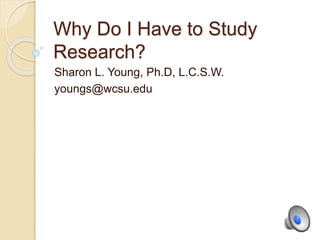
Class 1 introduction to research
- 1. Why Do I Have to Study Research? Sharon L. Young, Ph.D, L.C.S.W. youngs@wcsu.edu
- 2. Is social work an art or science? Is social work an art or science? ◦ What makes it an art? What do you bring to your practice? How to do you engage clients? ◦ What makes it science? How do you chose your intervention? How do you know your intervention works?
- 3. Treatment?
- 4. How do we know? What is the best way to treat depression? ◦ how do you justify your approach to your client? What is the best intervention to prevent teen pregnancy? ◦ Same geographically? ◦ Same demographically?
- 5. Holding Therapy Myeroff, R. G. M. J. G. (May 01, 2000). Comparative effectiveness of holding therapy with aggressive children. Sage Family Studies Abstracts, 22, 2.) This study was undertaken to assess the effects of holding therapy on children who have a history of aggressive and delinquent behaviors. The study design was a prospective, pre-post, quasi- experimental controlled study. The subjects were recruited through the Attachment Center at Evergreen, Colorado. All children had a history of aggressive and delinquent behaviors. Findings resulted in significant decrease in the outcome variables (aggression and delinquency) for the treatment group within this study.
- 6. Demonstration of Holding Therapy Demonstration of Neil Feinberg, social worker doing Holding Therapy :
- 7. Let’s take a closer look at the Study
- 8. Holding Therapy Pignotti and Mercer (2007): Holding Therapy and Dyadic Developmental Psychotherapy Are Not Supported and Acceptable Social Work Interventions: A Systematic Research Synthesis Revisited “Holding therapy, is shown to be potentially physically harmful to children. Detailed evidence is offered to show that holding therapy and dyadic developmental psychotherapy are not appropriately categorized as supported and acceptable interventions.”
- 9. What are our ways of knowing? Practice wisdom Experience How else do we know… ◦ Interventions to choose ◦ Which interventions work with what population? ◦ what we are doing is effective?
- 10. What is evidenced based practice? EBP is: “the conscientious, explicit, and judicious use of the best available scientific evidence in making decisions about the care of individual patients” - Sackett and colleagues
- 11. Steps to Evidenced Based Practice 1. Transform practice problems and challenges searchable questions. 2. Using key works and data basis to track down the best evidence 3. Evaluate the quality of the evidence 4. Discuss the evidence with clients, taking into account client preferences and setting constraints 5. Implement (use) the evidence in practice 6. Monitor and evaluate the intervention's effectiveness with the particular client with whom one is working. Source: Gambrell/Gibbs
- 12. Pitfalls of EBP Time constraints Lack of access to research Lack of time and resources Supervisors prefer practice wisdom Lack of agency support of EBP Resistance to EBP process
- 13. Benefits of EBP Without evidence: practice susceptible to fads malpractice litigation Accepted by managed care/third party payers. Allows client to review the evidence and decide with the practitioner the best treatment for him/her.